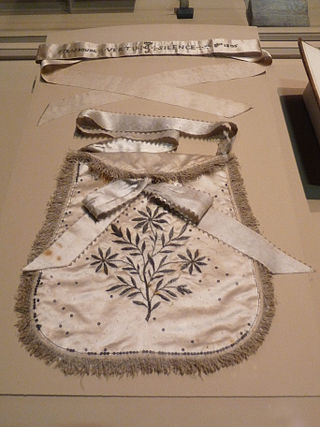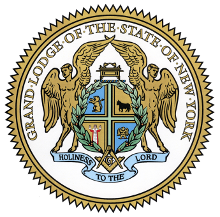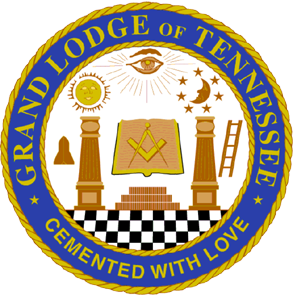
Freemasonry or Masonry refers to fraternal organisations that trace their origins to the local guilds of stonemasons that, from the end of the 14th century, regulated the qualifications of stonemasons and their interaction with authorities and clients. Modern Freemasonry broadly consists of two main recognition groups: Regular Freemasonry, which insists that a volume of scripture be open in a working lodge, that every member professes belief in a Supreme Being, that no women be admitted, and that the discussion of religion and politics do not take place within the lodge; and Continental Freemasonry, which consists of the jurisdictions that have removed some, or all, of these restrictions.
The history of Freemasonry encompasses the origins, evolution and defining events of the fraternal organisation known as Freemasonry. It covers three phases. Firstly, the emergence of organised lodges of operative masons during the Middle Ages, then the admission of lay members as "accepted" or "speculative" masons, and finally the evolution of purely speculative lodges, and the emergence of Grand Lodges to govern them. The watershed in this process is generally taken to be the formation of the first Grand Lodge in London in 1717. The two difficulties facing historians are the paucity of written material, even down to the 19th century, and the misinformation generated by masons and non-masons alike from the earliest years.
The relationship between Mormonism and Freemasonry began early in the life of Joseph Smith, founder of the Latter Day Saint movement. Smith's older brother, Hyrum, and possibly his father, Joseph, Sr. were Freemasons while the family lived near Palmyra, New York. In the late 1820s, the western New York region was swept with anti-Masonic fervor.
Anti-Masonry is "avowed opposition to Freemasonry", which has led to multiple forms of religious discrimination, violent persecution, and suppression in some countries as well as in various organized religions. However, there is no homogeneous anti-Masonic movement. Anti-Masonry consists of radically differing criticisms from frequently incompatible political institutions and organized religions that oppose each other, and are hostile to Freemasonry in some form.

The Most Worshipful Grand Lodge of Ancient Free and Accepted Masons of the Commonwealth of Massachusetts, commonly referred to as the Grand Lodge of Massachusetts and abbreviated GLMA, is the main governing body of Freemasonry within Massachusetts, and maintains Lodges in other jurisdictions overseas, namely Panama, Chile, the People's Republic of China, and Guantanamo Bay Naval Base, Cuba.
While many Christian denominations either allow or take no stance on their members joining Freemasonry, others discourage or prohibit their members from joining the fraternity.
James Anderson was a Scottish writer and minister born and educated in Aberdeen, Scotland. He was ordained a minister in the Church of Scotland in 1707 and moved to London, where he ministered to the Glass House Street congregation until 1710, to the Presbyterian church in Swallow Street until 1734, and at Lisle Street Chapel until his death. He is reported to have lost a large sum of money in the South Sea Company crash of 1720. Anderson is best known for his association with Freemasonry.

The Grand Lodge of Texas, Ancient Free and Accepted Masons is the largest of several governing bodies of Freemasonry in the State of Texas, being solely of the Ancients' tradition and descending from the Ancient Grand Lodge of England, founded on 17 June 1751 at the Turk's Head Tavern, Greek Street, Soho, London. According to historian James D. Carter, the "Grand Lodge of the Republic of Texas, A.F. & A.M." was founded on 16 April 1838. However, its first Grand Master and other grand officers were installed by Sam Houston on 11 May 1838. The Grand Lodge of Texas is one of the largest in the world, reporting 69,099 members in 2019. The current Grand Lodge of Texas facilities were made possible by the fundraising efforts of Waco Masonic Lodge No. 92.
Masonic landmarks are a set of principles that many Freemasons claim to be ancient and unchangeable precepts of Masonry. Issues of the "regularity" of a Freemasonic Lodge, Grand Lodge or Grand Orient are judged in the context of the landmarks. Because each Grand Lodge is self-governing, with no single body exercising authority over the whole of Freemasonry, the interpretations of these principles can and do vary, leading to controversies of recognition. Different Masonic jurisdictions have different landmarks.

Freemasonry has had a complex relationship with women for centuries. A few women were involved in Freemasonry before the 18th century, despite de jure prohibitions in the Premier Grand Lodge of England.
The Order of Women Freemasons is an organisation based in the United Kingdom and is the larger of the two Masonic bodies for women only. Its headquarters is at 27 Pembridge Gardens in London.

The Order of Free Gardeners is a fraternal society that was founded in Scotland in the middle of the 17th century and later spread to England and Ireland. Like numerous other friendly societies of the time, its principal aim was the sharing of secret knowledge linked to the profession and mutual aid. In the 19th century, its activities of mutual insurance became predominant. By the end of the 20th century, it had become almost entirely extinct, but that can be revised due to some growth in the early 21st century.

This is a chronology of the formation of "regular" or "mainstream" Masonic Grand Lodges in North America, descending from the Premier Grand Lodge of England or its rival, the Antient Grand Lodge of England. A Grand Lodge is the governing body that supervises "Craft" Freemasonry in a particular jurisdiction or geographical area.

The Grand Lodge of New York is the largest and oldest independent organization of Freemasons in the U.S. state of New York. The headquarters of the Grand Lodge is the Grand Lodge Building located at 23rd Street in Manhattan.
Masonic College was a higher education institution in Missouri that was established by Freemasons in 1844 and operated until 1857.

A fraternity or fraternal organization is an organization, society, club or fraternal order traditionally of men associated together for various religious or secular aims. Fraternity in the Western concept developed in the Christian context, notably with the religious orders in the Catholic Church during the Middle Ages. The concept was eventually further extended with medieval confraternities and guilds. In the early modern era, these were followed by fraternal orders such as Freemasons and Odd Fellows, along with gentlemen's clubs, student fraternities, and fraternal service organizations. Members are occasionally referred to as a brother or – usually in a religious context – frater or friar.
A Masonic Temple or Masonic Hall is, within Freemasonry, the room or edifice where a Masonic Lodge meets. Masonic Temple may also refer to an abstract spiritual goal and the conceptual ritualistic space of a meeting.

The Alabama Institute for Deaf and Blind (AIDB) is the world’s most comprehensive education, rehabilitation and service program serving individuals of all ages who are deaf, blind, deafblind and multidisabled. It is operated by the U.S. state of Alabama in the city of Talladega. The current institution includes the Alabama School for the Deaf, the Alabama School for the Blind, and the Helen Keller School of Alabama, named for Alabamian Helen Keller, which serves children who are both deaf and blind. E. H. Gentry Facility provides vocational training for adult students, and the institution offers employment through its Alabama Industries for the Blind facilities in Talladega and Birmingham. AIDB has regional centers in Birmingham, Decatur, Dothan, Huntsville, Mobile, Montgomery, Opelika, Shoals, Talladega, and Tuscaloosa. AIDB currently serves over 36,000 residents from all 67 counties of the state.

The Grand Lodge of Tennessee, officially the Grand Lodge of the Ancient and Honorable Fraternity of Free and Accepted Masons of the State of Tennessee, is the main governing body of Freemasonry within Tennessee. This Grand Lodge was established in Knoxville, Tennessee, on December 27, 1813, by nine Masonic lodges operating within the state. In 2017, the Grand Lodge of Tennessee had a reported membership of 34,858 Master Masons, and by 2020 the membership had fallen only slightly to 33,200.
Alabama Female Institute was one of the earliest educational institutions for women organized in Alabama. It opened in Tuscaloosa, in the fall of 1829, as "Sims' Female Academy". In 1831, it became the "Tuscaloosa Female Academy". The name change to Alabama Female Institute occurred in 1833, and this school was chartered in 1835. It continued to operate until 1888, when the property was sold to the city of Tuscaloosa for public school purposes.










